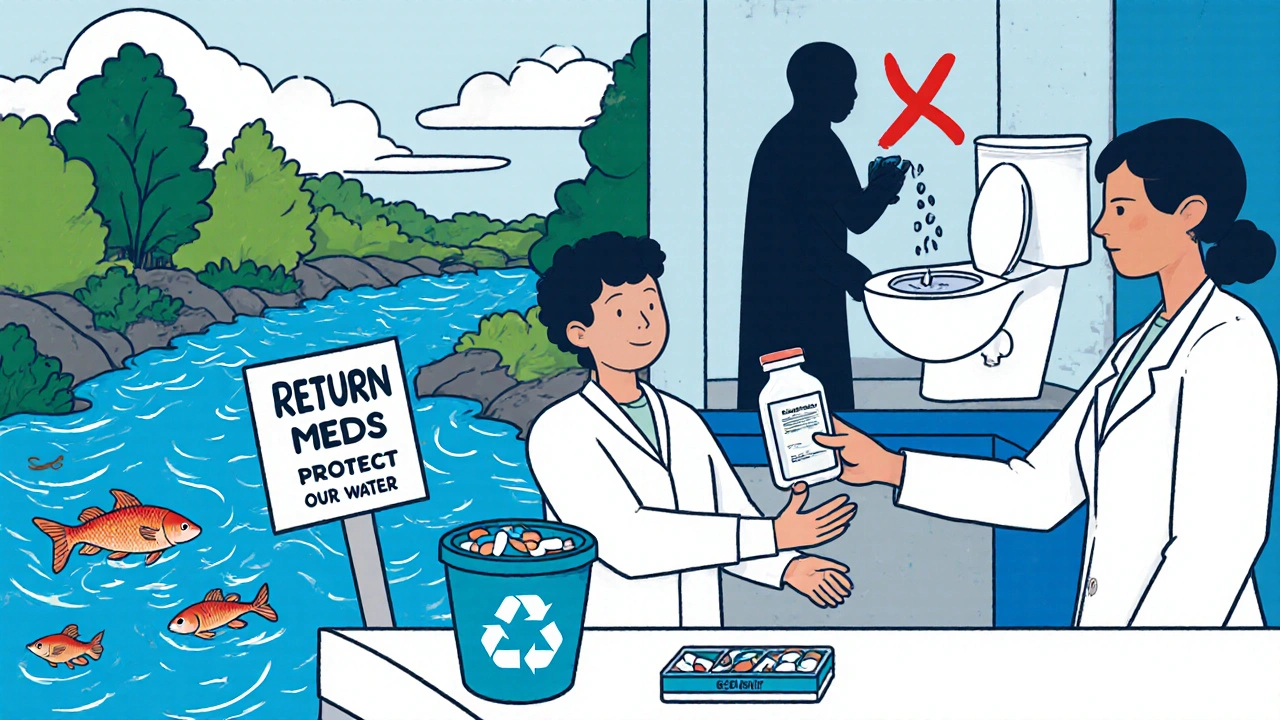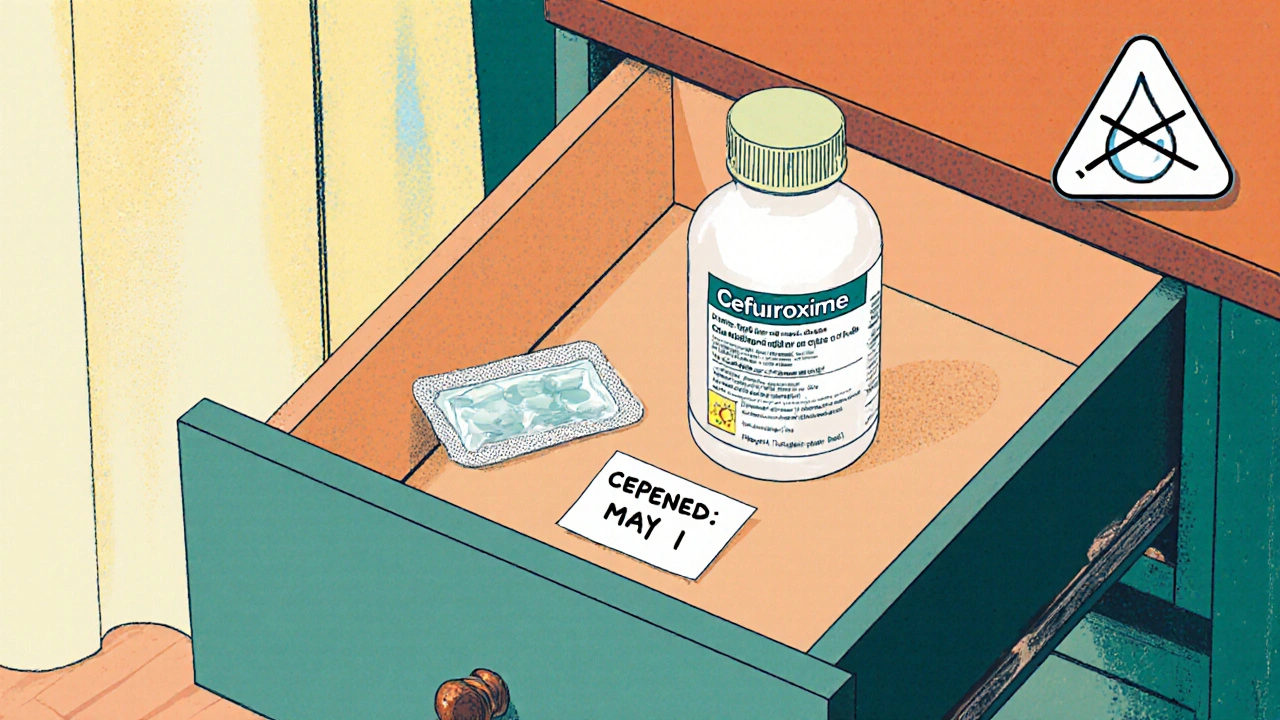Keeping cefuroxime at the right temperature and throwing it away properly isn’t just about following rules-it’s about keeping your family safe and protecting the environment. Many people don’t realize that leaving antibiotics like cefuroxime in a hot bathroom cabinet or flushing them down the toilet can do more harm than good. This guide walks you through exactly how to store cefuroxime so it stays effective, and how to dispose of it without risking contamination, accidental poisoning, or water pollution.
How to Store Cefuroxime Correctly
Cefuroxime comes in tablets, oral suspension, and sometimes as an injectable form. Each type has different storage needs. The most common version-oral tablets-should be kept in a cool, dry place away from moisture and heat. That means no bathroom cabinets, no windowsills, and definitely not the kitchen near the stove. A bedroom drawer or a shelf in a closet works better.
The liquid suspension form is more sensitive. Once mixed by the pharmacist, it must be refrigerated between 2°C and 8°C (36°F-46°F). Don’t freeze it. If left out at room temperature for more than 24 hours, it loses strength and can grow bacteria. Always check the label on the bottle-it’ll say how long it lasts after mixing. Most suspensions expire after 10 days, even if refrigerated.
Keep cefuroxime in its original container with the child-resistant cap tightly closed. Never transfer it to a pill organizer unless you’re using it within a day or two. The packaging has important details like expiration date, batch number, and storage instructions printed on it. If you lose the label, don’t guess-call your pharmacy. Taking expired or improperly stored cefuroxime won’t just fail to treat your infection-it could make things worse by encouraging antibiotic resistance.
Why Improper Storage Matters
Antibiotics don’t just go bad like milk. They break down chemically when exposed to heat, light, or humidity. A study published in the Journal of Antimicrobial Chemotherapy found that cefuroxime tablets stored at 35°C (95°F) for 30 days lost up to 20% of their potency. That means if you’re taking a weakened dose, the bacteria in your body might survive and become harder to kill next time.
Children and pets are at risk too. One in five accidental poisonings in UK households under age five involves medications left within reach. Cefuroxime isn’t deadly in small amounts, but it can cause vomiting, diarrhea, or allergic reactions. Keep it locked up or out of sight-preferably in a high cabinet with a latch.
When to Throw Away Cefuroxime
Don’t keep leftover cefuroxime for "next time." Antibiotics are prescribed for specific infections, and using old or leftover doses for a new illness can mask symptoms, delay proper diagnosis, and increase the chance of resistant superbugs. Here’s when to toss it:
- After you finish the full course-even if you feel better
- If the expiration date has passed
- If the tablets are discolored, cracked, or smell strange
- If the liquid suspension looks cloudy or has particles in it
- If it’s been stored incorrectly (e.g., left in a hot car)
Even if the medication looks fine, if it’s been more than a few months past the expiry date, throw it out. The NHS recommends not keeping any antibiotics longer than six months after filling the prescription, unless otherwise directed by a doctor.

How to Dispose of Cefuroxime Safely
Never flush cefuroxime down the toilet or sink. Never throw it in the regular trash without taking steps to make it unusable. Both methods can contaminate water supplies and harm wildlife. The UK’s National Health Service (NHS) and the Environment Agency both warn that pharmaceutical pollution is a growing problem-antibiotics have been found in rivers, lakes, and even drinking water.
Here’s the right way to dispose of it:
- Take unused or expired cefuroxime to your local pharmacy. Most UK pharmacies offer free take-back programs. Just bring the bottle in-no receipt needed.
- If your pharmacy doesn’t take it, find a designated drug disposal site. Use the NHS website’s Find a Medicine Return Point tool to locate one near you.
- If no take-back option is available, mix the tablets or liquid with something unappetizing: used coffee grounds, cat litter, or dirt. Put it in a sealed plastic bag and throw it in your household trash. This makes it unappealing to children, pets, or people who might go through the bin.
Remove or black out your name and prescription details on the label before throwing the bottle away. This protects your privacy. The empty bottle itself can usually be recycled-check your local council’s guidelines.
What Not to Do
These common mistakes put your health and the environment at risk:
- Sharing your cefuroxime with someone else-even if they have similar symptoms. What works for you might not work for them, and could cause a dangerous reaction.
- Keeping it in the car during summer. Temperatures inside parked cars can hit 50°C (122°F), which destroys the drug’s effectiveness.
- Using old prescriptions for new infections. Coughs, earaches, and sore throats aren’t always bacterial. Taking antibiotics when they’re not needed fuels resistance.
- Washing pills down the drain because it’s "convenient." This contaminates water systems and contributes to antibiotic-resistant bacteria in the environment.

What Happens If You Don’t Dispose of It Right?
When antibiotics enter waterways, they don’t break down easily. Microorganisms in rivers and soil start adapting to survive them. Over time, this leads to bacteria that no longer respond to common drugs. The World Health Organization calls antibiotic resistance one of the biggest threats to global health.
In the UK, around 5,000 deaths each year are linked to infections that can’t be treated with standard antibiotics. Proper disposal of drugs like cefuroxime is one small action that helps slow this trend. It’s not just about your health-it’s about protecting the next generation’s ability to treat infections.
When to Talk to Your Pharmacist
If you’re unsure how to store your cefuroxime, or if you have leftover medicine and don’t know where to take it, ask your pharmacist. They’re trained to help with this. You can also call NHS 111 for advice on disposal options in your area.
Some pharmacies offer home collection services for unused medicines, especially for elderly or mobility-limited patients. Ask if this is available near you. Many community pharmacies in Bristol, Cardiff, and Manchester now run these services free of charge.
Final Tips for Safe Handling
- Write the date you opened the bottle on the label-this helps you track freshness.
- Keep a small logbook of all antibiotics you’ve taken, including dates and doses. This helps your doctor avoid dangerous interactions.
- Teach kids that medicine isn’t candy. Even if it’s sweet-tasting, never let them handle it without supervision.
- If someone accidentally swallows cefuroxime they weren’t prescribed, call NHS 111 immediately. Don’t wait for symptoms to appear.
Proper storage and disposal of cefuroxime isn’t complicated-but it does require attention. Treat it like you would any other medicine that affects your body’s balance: with care, respect, and responsibility.
Can I store cefuroxime in the fridge if I don’t have a cool, dry place?
Only if it’s the liquid suspension form. Tablets should stay at room temperature. Refrigerating tablets can cause moisture buildup inside the bottle, which may degrade the medication. If you don’t have a cool, dry spot, store tablets in a sealed container with a silica gel packet (like those found in new shoe boxes) to absorb moisture.
What if I accidentally left my cefuroxime in the car all day?
If the temperature in your car went above 30°C (86°F), the medicine may have lost potency. Don’t take it. Bring it to your pharmacy for safe disposal. If you’re in the middle of treatment and can’t get a replacement right away, contact your doctor-they may be able to issue a new prescription or suggest alternatives.
Can I flush cefuroxime if there’s no disposal site nearby?
No. Flushing is never recommended, even if there’s no take-back program. Instead, mix the tablets with used coffee grounds or cat litter, seal them in a plastic bag, and put them in your household trash. This is the safest option when no other method is available.
How long does cefuroxime last after mixing the liquid?
Most cefuroxime suspensions are stable for 10 days when refrigerated. Check the label or ask your pharmacist-the exact time depends on the manufacturer. Never use it past that date-even if it looks fine. Bacteria can grow in the liquid over time, making it unsafe.
Is it safe to give leftover cefuroxime to my child if they have the same symptoms as last time?
No. Every infection is different. What worked for a sore throat last time might not help an ear infection now. Using old antibiotics can lead to incomplete treatment, which encourages resistant bacteria. Always see a doctor before giving any antibiotic to a child.

10 Comments
Margaret WilsonNovember 19, 2025 AT 16:07
Oh wow, finally someone who gets it! 🙌 I used to toss my antibiotics in the trash like it was last week’s pizza box… until my dog got sick. Now I treat meds like nuclear waste. #NoMoreFlushingwilliam volcoffNovember 20, 2025 AT 04:49
Actually, the fridge thing is tricky. Tablets don’t belong there-moisture from condensation can degrade them faster than heat. Silica gel packets? Smart. I keep mine in a sealed mason jar with a desiccant. Works better than any cabinet.Brad SamuelsNovember 20, 2025 AT 21:13
It’s wild how we treat medicine like it’s just another household item. We don’t leave gasoline in the bathroom, but we’ll leave antibiotics in the same drawer as our toothpaste. We’re not just careless-we’re disconnected from the consequences.Mary FolleroNovember 22, 2025 AT 08:42
I started keeping a little meds logbook after my mom mixed up her blood pressure pills and ended up in the ER. Now I write the date I open every bottle. Also, I tell my niece: ‘Medicine isn’t candy, it’s a tool.’ She’s 4. She listens. Small wins, y’all.Arun MohanNovember 22, 2025 AT 23:06
Honestly, this is just basic pharmacology 101. If you’re reading this because you didn’t know how to store cefuroxime, maybe you shouldn’t be self-managing prescriptions. The real issue is the overprescribing culture. But sure, let’s all obsess over the packaging.Tyrone LutonNovember 23, 2025 AT 07:01
We’ve been conditioned to believe that every cough needs a pill. That’s not medicine-it’s corporate marketing disguised as healthcare. The fact that we’re even debating how to dispose of antibiotics means we’ve already lost the war.Herbert ScheffknechtNovember 23, 2025 AT 17:59
I once left my cefuroxime in my car for a week during a heatwave. I thought, ‘eh, it’s fine.’ Turns out, the pills turned yellow. I took one anyway. Got a rash. Then I got curious. So I dug into the literature. Turns out, degraded beta-lactams can trigger allergic responses even if you’ve never been allergic before. Mind blown. Now I check the color. Always.Jessica EngelhardtNovember 24, 2025 AT 06:13
NHS says this but the FDA says that. Meanwhile, Big Pharma is laughing all the way to the bank. You think they care if you flush your pills? They want you to keep buying. This is a distraction. Real change? Stop prescribing antibiotics like candy.Danielle MazurNovember 25, 2025 AT 13:04
This guide is a psyop. The government doesn’t want you to know that most antibiotics are designed to fail after 10 days so you’ll buy more. The silica gel trick? That’s what they want you to think is safe. Real talk: if you’re not storing meds in a Faraday cage, you’re already compromised.Martin RodrigueNovember 26, 2025 AT 06:21
The referenced Journal of Antimicrobial Chemotherapy study used accelerated stability testing under ICH guidelines. The 20% potency loss at 35°C aligns with ICH Q1A(R2) degradation models. However, the 10-day suspension shelf-life is conservative-real-world data from NHS England shows 12–14 days under controlled refrigeration with minimal light exposure. Always verify with manufacturer’s IFU.